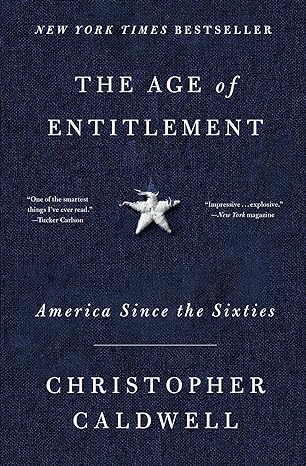A Brief Book Summary from Books At a Glance
by Benjamin J. Montoya, PhD
About the Author
Christopher Caldwell is a contributing editor at the Claremont Review of Books and a contributing opinion writer for The New York Times. He was previously a senior editor at the Weekly Standard and a columnist for the Financial Times. He is the author of The Age of Entitlement: America Since the Sixties and Reflections on the Revolution in Europe: Immigration, Islam and the West.
Introduction
The US has changed drastically since the 60s, in ways that would have been unthinkable before. There is a new kind of entitlement that has created new requirements, taken away certain constitutional rights, and has sought to retool the constitution. What is this movement all about? Has this movement been successful? Although the efforts of this movement persist, as we continue to see even in recently released films, this effort has ultimately not had the impact for which it had hoped. Consider our important summary to learn more about this supposed “civil rights movement” to understand our culture more thoroughly with the hopes of engaging with it further.
Table of Contents
Part I The Revolutions of the 1960s
Chapter 1 1963
Chapter 2 Race
Chapter 3 Sex
Chapter 4 War
Part II The New Construction
Chapter 5 Debt
Chapter 6 Diversity
Chapter 7 Winners
Chapter 8 Losers
Summary
Part I: The Revolutions of the 1960s
Chapter 1: 1963
After the death/assassination of J. F. Kennedy, this country changed drastically. Before his death, this country was viewed as a gift, and he was leading the way for a lot of changes. But after his death, the civil rights movement largely took over in the political area. Civil rights ideology became the model of an entirely new system of political reform. This was not just meant to be part of what people knew in their political system. This civil rights movement intended to replace what was there in toto. It was a rival constitution of sorts that demanded allegiance. People within this movement are not content to be part of a democracy; they want people to take sides, ideally for their movement, but take sides, nonetheless. It is this poisonous conflict that this book describes.
Chapter 2: Race
The new civil rights movement began to focus its attention on race. Instead of focusing on the larger issues at hand, this one single issue, though important, became the sledgehammer used to break what had been in place before politically and in the private sphere of this country without a construction crew to come in to replace it with anything else. What it was trying to destroy was viewed through the lens of race, as though something was immediately oppressive and racist.
In addition to being a sledgehammer of sorts, it also became a license for the government to do whatever it wanted in the name of affirmative action and political correctness. The constitution never granted the government these kinds of broad-ranging authority, but the civil rights movement took it to that end. The larger underlying problem is that this civil rights agenda cannot be merely added to the existing constitution. For this movement to establish new liberties and ways of doing things in both the political and private spheres, it had to extinguish things it did not like. For example, freedom of association was something that people had previously enjoyed and had. Now instead of viewing that as an issue separate from race, the proverbial waters were muddied through conflict in the courts and public sphere to make the issue of association the same as that of race, granting the civil rights movement all kinds of power over it.
The result of all this work is that this system of overthrowing what was seen in America because the template for overthrowing every other tradition in American life, continuing on with the roles of men and women. This movement never intended to stop after achieving what they perceived as success in one area. . . .
[To continue reading this summary, please see below....]The remainder of this article is premium content. Become a member to continue reading.
Already have an account? Sign In
